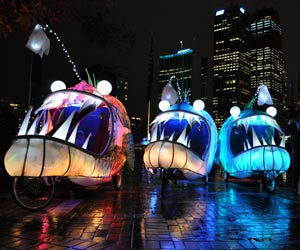Aquaculture isn’t just about seafood anymore. The future of sustainable aquaculture lies in farms that not only grow nutritious food, but also offer a robust business that serves multiple sectors of the economy while improving the environment.
“We’re talking about providing biofuel, organic fertilizer, and food while also restoring the environment.”
That’s how Bren Smith, founder of Thimble Island Oysters, summed up his big vision for saving oysters and the planet at a recent workshop put on by Future of Fish.
And how to do that?
Start farming seaweeds (or, as we science nerds call it, macroalgae) in addition to shellfish and/or fish.
It wasn’t the first time I heard this answer. The role of seaweed in saving the seas was something I had begun to think about over four years ago when I invited Stephen Cross to speak on a panel about how entrepreneurs could help save seafood and the sea. His version of the multi-species model, Pacific SEA-lab in British Columbia, includes sablefish, mussels, sea cucumbers, oysters and kelp. Known as Integrated Multi-Trophic Aquaculture (IMTA), variations are springing up all over the globe, including a pilot study in the Bay of Fundy to test how mussels and kelp can benefit from (and help counter-act the negative effects of ) established salmon farms and an Israeli company call SeaOr Marine Enterprises that integrates seabream, seaweeds, and abalone.
The future of aquaculture is all about diversifying the products and spreading the risk for ocean farmers. But the future of the planet is about creating businesses that can help, rather than harm, the ecosystem. Farming seaweed alongside other marine species does both. It’s one of the opportunities the SOCAP13 Oceans track recently introduced to impact investors. And if that audience gets this big picture, it could really take things to the next level.
The rapid turnover rate of seaweed helps to balance out the slower-growing fish or shellfish, providing a harvestable crop that can help carry the farm when natural disasters (such as hurricane Sandy) or disease threaten the more sensitive species.
For example, Bren’s 300 sq ft plot can grow 24 tons of kelp every three to five months. If you are thinking “that’s a lot of sushi wrappers,” I agree. But kelp is far more versatile than that. Adventurous and creative chefs are already concocting kelp ice cream, seaweed fettucine, and yes, a happy hour kelp cocktail. But the use of kelp is not just in the food business. This nutritious seaweed is also a source of biofuel, and its high nitrogen content makes it a great source of organic fertilizer.
As an investor, these farms offer the opportunity to invest in different sectors of the economy: seafood, agriculture (through fertilizers) and energy.
But, they do something else too.
Growing seaweeds helps to combat climate change and clean the water. Kelp forests sequester more carbon dioxide than trees on land. This means IMTA farms can serve as a Blue Carbon source—a coastal habitat that stores carbon, helping to reduce the impact of climate change. At the same time, shellfish and kelp both absorb nitrogen, reducing the effect of terrestrial run-off. With carbon and nitrogen trading schemes already underway, IMTA ventures offer potential returns based on these environmental services, in addition to the products.
Dozens of IMTA research projects and already-established businesses are underway. But, to move from pilot project to commercial farm, or from small-scale to large-scale operations, requires funds. Bren recently turned to Kickstarter to generate the necessary funds to scale his operation (check out the link for a great video about his farm). But investors can take it to the next level. If they can see the multiple benefits and investment promise of IMTAs it could really change the financial playing field for ocean health. I’m keeping my kelp fronds crossed that they do.
